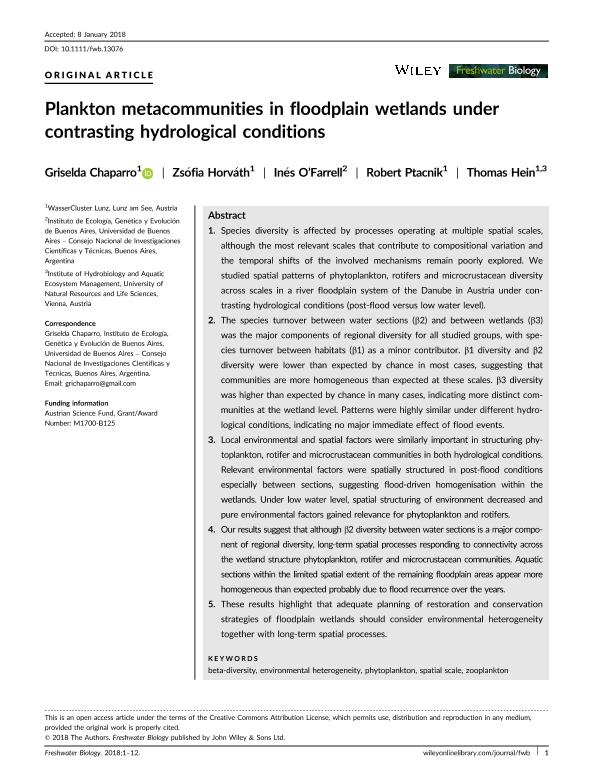Mostrar el registro sencillo del ítem
dc.contributor.author
Chaparro, Griselda Noemí

dc.contributor.author
Horváth, Zsófia
dc.contributor.author
O'farrell, Ines

dc.contributor.author
Ptacnik, Robert
dc.contributor.author
Hein, Thomas
dc.date.available
2020-02-03T20:52:32Z
dc.date.issued
2018-04
dc.identifier.citation
Chaparro, Griselda Noemí; Horváth, Zsófia; O'farrell, Ines; Ptacnik, Robert; Hein, Thomas; Plankton metacommunities in floodplain wetlands under contrasting hydrological conditions; Wiley Blackwell Publishing, Inc; Freshwater Biology (print); 63; 4; 4-2018; 380-391
dc.identifier.issn
0046-5070
dc.identifier.uri
http://hdl.handle.net/11336/96630
dc.description.abstract
Species diversity is affected by processes operating at multiple spatial scales, although the most relevant scales that contribute to compositional variation and the temporal shifts of the involved mechanisms remain poorly explored. We studied spatial patterns of phytoplankton, rotifers and microcrustacean diversity across scales in a river floodplain system of the Danube in Austria under contrasting hydrological conditions (post-flood versus low water level). The species turnover between water sections (β2) and between wetlands (β3) was the major components of regional diversity for all studied groups, with species turnover between habitats (β1) as a minor contributor. β1 diversity and β2 diversity were lower than expected by chance in most cases, suggesting that communities are more homogeneous than expected at these scales. β3 diversity was higher than expected by chance in many cases, indicating more distinct communities at the wetland level. Patterns were highly similar under different hydrological conditions, indicating no major immediate effect of flood events. Local environmental and spatial factors were similarly important in structuring phytoplankton, rotifer and microcrustacean communities in both hydrological conditions. Relevant environmental factors were spatially structured in post-flood conditions especially between sections, suggesting flood-driven homogenisation within the wetlands. Under low water level, spatial structuring of environment decreased and pure environmental factors gained relevance for phytoplankton and rotifers. Our results suggest that although β2 diversity between water sections is a major component of regional diversity, long-term spatial processes responding to connectivity across the wetland structure phytoplankton, rotifer and microcrustacean communities. Aquatic sections within the limited spatial extent of the remaining floodplain areas appear more homogeneous than expected probably due to flood recurrence over the years. These results highlight that adequate planning of restoration and conservation strategies of floodplain wetlands should consider environmental heterogeneity together with long-term spatial processes.
dc.format
application/pdf
dc.language.iso
eng
dc.publisher
Wiley Blackwell Publishing, Inc

dc.rights
info:eu-repo/semantics/openAccess
dc.rights.uri
https://creativecommons.org/licenses/by-nc-sa/2.5/ar/
dc.subject
BETA-DIVERSITY
dc.subject
ENVIRONMENTAL HETEROGENEITY
dc.subject
PHYTOPLANKTON
dc.subject
SPATIAL SCALE
dc.subject
ZOOPLANKTON
dc.subject.classification
Biología Marina, Limnología

dc.subject.classification
Ciencias Biológicas

dc.subject.classification
CIENCIAS NATURALES Y EXACTAS

dc.title
Plankton metacommunities in floodplain wetlands under contrasting hydrological conditions
dc.type
info:eu-repo/semantics/article
dc.type
info:ar-repo/semantics/artículo
dc.type
info:eu-repo/semantics/publishedVersion
dc.date.updated
2019-10-09T20:44:55Z
dc.journal.volume
63
dc.journal.number
4
dc.journal.pagination
380-391
dc.journal.pais
Reino Unido

dc.journal.ciudad
Londres
dc.description.fil
Fil: Chaparro, Griselda Noemí. Wassercluster Lunz; Austria. Consejo Nacional de Investigaciones Científicas y Técnicas. Oficina de Coordinación Administrativa Ciudad Universitaria. Instituto de Ecología, Genética y Evolución de Buenos Aires. Universidad de Buenos Aires. Facultad de Ciencias Exactas y Naturales. Instituto de Ecología, Genética y Evolución de Buenos Aires; Argentina
dc.description.fil
Fil: Horváth, Zsófia. Wassercluster Lunz; Austria
dc.description.fil
Fil: O'farrell, Ines. Consejo Nacional de Investigaciones Científicas y Técnicas. Oficina de Coordinación Administrativa Ciudad Universitaria. Instituto de Ecología, Genética y Evolución de Buenos Aires. Universidad de Buenos Aires. Facultad de Ciencias Exactas y Naturales. Instituto de Ecología, Genética y Evolución de Buenos Aires; Argentina
dc.description.fil
Fil: Ptacnik, Robert. Wassercluster Lunz; Austria
dc.description.fil
Fil: Hein, Thomas. Universitat Fur Bodenkultur Wien; Austria. Wassercluster Lunz; Austria
dc.journal.title
Freshwater Biology (print)

dc.relation.alternativeid
info:eu-repo/semantics/altIdentifier/url/https://onlinelibrary.wiley.com/doi/full/10.1111/fwb.13076
dc.relation.alternativeid
info:eu-repo/semantics/altIdentifier/doi/https://doi.org/10.1111/fwb.13076
Archivos asociados
